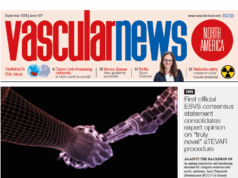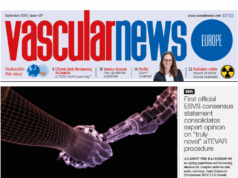
Updated European Society for Vascular Surgery (ESVS) clinical practice guidelines regarding the management of diseases of the descending thoracic aorta have been published in the European Journal of Vascular and Endovascular Surgery.
Chaired by Vincent Riambau, Barcelona, Spain, the Descending Thoracic Aorta Writing Committee was appointed by the ESVS to produce new guidelines for surgeons and other physicians involved in the overall care of patients with descending thoracic aortic disorders. Vascular News spoke to Riambau about why the project was undertaken and some of the key recommendations that the Writing Committee made.
Why was it important to create new guidelines for descending thoracic aortic disease?
The creation of guidelines for the clinical practice is one of the ESVS missions. The goal is to improve the decision-making process, decreasing variability in vascular surgical care within Europe. That is especially important when we face descending thoracic diseases, because there are many different clinical scenarios and with different therapeutic alternatives.
The Writing Committee included ESVS members from several nations. Why was this variety important?
We tried to include as many nationalities as possible, from different cultures and different economic statuses, in order to get the maximum input and consensus. Since level A evidence does not exist in descending thoracic aorta management, it is especially relevant to get the highest consensus to harmonise the medical care for such pathologies through over Europe. For the same reason we invited document reviewers from other countries beyond Europe and non-ESVS members.
What are some of the key recommendations made in the document?
The ESVS guidelines are quite consistent with the most recent ESC guidelines. However, there are some key recommendations that made those guidelines different than guidelines previously published. For example, centralisation for the most complex open and endovascular procedures like thoraco-abdominal aneurysms and dissections is clearly recommended.
We included a class IIb recommendation for uncomplicated acute type B dissections; they may be considered selectively for early endovascular treatment. Moreover, in patients at risk of further aortic complications with suitable anatomy for endografting, endovascular repair of uncomplicated chronic type B dissections should be considered in the subacute phase, in dedicated centres. That is a class IIa recommendation. It is also important to emphasise that open repair as well endovascular repair should be followed-up years after the procedures.
Finally, we recognised the huge gap in evidence in the majority of the descending thoracic aorta diseases. That means, there is a lot of room for new knowledge and improving evidence. However, it seems very difficult to carry on randomised controlled trials. We would need more large non-randomised studies and meta-analyses.
What challenges did you face in creating these guidelines?
Coordinating a large number of authors is not an easy job. Fortunately, the writing committee was well-selected and all the contributors worked very hard.
The heaviest task was related to the revisions made by the reviewers; at least five revision runs were performed. When different reviewers give different opinions and comments for a single recommendation, it can be very challenging to find consensus. This was common because of the lack of evidence.
What effect do you and your colleagues hope the guidelines will have on treatment?
We hope to harmonise the descending thoracic aorta management throughout Europe. ESVS’ Descending Thoracic Aorta Management Guidelines offer the best medical evidence available and the best consensus amongst key experts in the field. These guidelines represent a good referral document for the best clinical practice and can help our colleagues in the decision-making process. Additionally, pubic health authorities can also be educated on recent experiences in this area.
What areas of thoracic aortic disease are still controversial and lack consensus?
There are two important areas: we need more knowledge and consensus about TEVAR indications for uncomplicated acute and chronic type B dissection. Also controversial is whether endovascular repair of thoracoabdominal aneurysms is superior to open repair, because of some durability issues. We hope that technological improvements and monitoring by large non-randomised studies will contribute to clarify these controversies.












